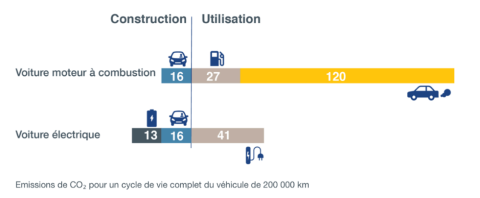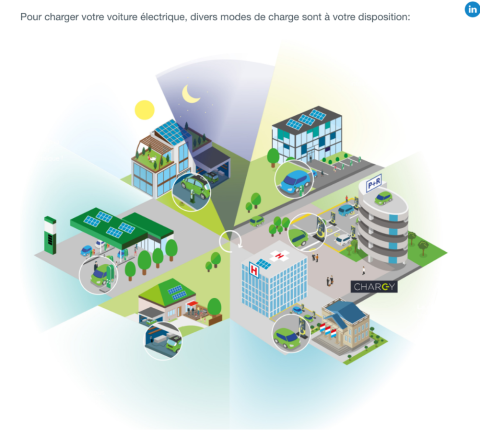Zero- or low-emission vehicles emit no or very low CO2 emissions and pollutants. As they are also cheaper to run than internal combustion engines, they offer considerable advantages, especially for everyday use.
Opting for eco-mobility means changing my everyday travel habits and choosing soft and electric mobility solutions that allow me to reduce my impact on the environment. Over the course of a day, I use public transport, cycle and walk. What matters most is finding a combination that works for me.
As one solution for the energy and travel challenges of tomorrow, eco-mobility should not be overlooked. That is why I am doing my part today.
- Bicycles, whether electric or not, are not only free of CO2 emissions, but they are also one of the cheapest and fastest means of transport for short distances. Thanks to my mKaart, I can store my bike in one of the mBoxes available in Luxembourg. mBoxes are conveniently located close to public transport hubs.
- Public transport: By taking the bus, tram or train, I can reduce my ecological footprint, avoid traffic jams and save money in the process.
- Carpooling: On average, cars with over 250,000 empty seats arrive in Luxembourg City every day. Carpooling allows me to share a vehicle with other commuters. This not only saves costs and decreases greenhouse gas emissions, but also reduces road congestion and traffic jams.
- Electric mobility is both innovative and efficient: the electric car is an environmentally friendly and sustainable means of transport. Thanks to the over 3000 publicly accessible charging stations in the country, I can easily charge my vehicle in public places.
Reducing my impact on the environment
By combining modes of travel, be it public transport, cycling, walking or even driving an electric vehicle, I can contribute to the reduction of greenhouse gas emissions.
Zero- or low-emission vehicles are an essential part of the sustainable energy transition: as their name suggests, zero- or low-emission vehicles emit very low quantities carbon emissions.

Zero- or low-emission vehicles are therefore more energy-efficient and have a markedly lower environmental footprint than internal combustion engine vehicles:
- during their life cycle (200,000 km), they have a lower environmental footprint than internal combustion engine vehicles (70 g CO2 / km compared to 163 g CO2 / km)*;
- they are quiet and produce a negligible quantity of local emissions (no NOx or CO2 emissions, less particulate matter) and therefore contribute to improving air quality and quality of life;
- the continuous optimisation of manufacturing processes and the reuse and recycling of batteries can prevent a scarcity of resources in the long term.
To further reduce my carbon footprint, I can take advantage of various offers provided by electricity suppliers that allow me to run my electric vehicle entirely on renewable energy.
More information on green electricity offers can be found at www.oekotopten.lu or calculix.lu
* Source : Modu 2.0, Transport & Environment, 2017
Saving money thanks to lower operating costs
On average, electric vehicles are cheaper to run than vehicles with combustion engines. This is not only because electric vehicles are less dependent on fluctuating fuel prices, but also because of savings on the CO2 tax. In 2021, the CO2 tax of €20 per tonne had already led to an increase of 5 to 6 cents per litre of fuel on 1 January 2021. An additional tax of €5 per tonne will be levied in 2022 and 2023.**
This policy is part of the implementation of the Integrated National Energy and Climate Plan (PNEC) and contributes to meeting the CO2 emission reduction targets.
The government’s social compensation policies emphasise social equity. For example, the tax credits for employees (CIS), pensioners (CIP) and self-employed individuals (CII) as well as the cost-of-living allowance have been increased since 1 January 2021.
In addition, electric vehicles have lower maintenance costs than vehicles with combustion engines. Electric vehicles do not require oil changes and there is no need to replace spark plugs or catalytic converters. In addition, electric vehicles use regenerative braking mechanisms, which means that brake pads last longer.***
There is even more.
When I purchase a zero-emission or low-emission vehicle, I can save additional money by benefiting from government subsidies.
Discover the Klimabonus simulator
**Source : https://today.rtl.lu/news/luxembourg/a/1815526.html
***Source : https://blog.evsolutions.com/how-expensive-is-ev-maintenance
Contributing to a better quality of life for me and my environment
Electric vehicles are quieter than vehicles with combustion engines. Combined with lower exhaust emissions, this reduces noise and air pollution, especially in urban centres. Electric vehicles are not only good for the environment, but also for my own well-being.
Electric vehicles also offer a comfortable driving experience as well as smooth, quiet acceleration. Moreover, the average daily car journey in Luxembourg is 40 km - no problem for electric vehicles averaging a range of over 300 km.
Electric vehicle charging made easy
Charging my electric vehicle is practical and easy. I can conveniently charge my electric vehicle at home, at work or at one of the many public charging stations in Luxembourg.

- Charging my electric car at home/at a friend's house: I can charge my car at a permanently installed wall charging station or occasionally even at an electric socket. For reasons of convenience and safety, it is recommended to install a wall charging station at home. For single-family homes, a charging station with a maximum charging power of 11 kW is recommended. To find out which charging station best suits my needs, I can compare the home charging stations available on the Luxembourg market and contact a professional installer.
- Charging my car at work: check with your employer if you can use on-site charging facilities. Some smart charging stations allow individual billing of electricity consumption.
- Public charging: public charging stations can be found at frequently visited locations such as town halls, hospitals or P+R facilities. These charging stations are accessible with my charging or credit card and provide a charging power of 3.7 to 22 kW generated entirely from green electricity. I can find my nearest Chargy charging station at: bit.ly/GP-charging_stations
- Fast charging: the installation of super-fast charging stations in Luxembourg has begun, allowing charging powers of more than 22 kW. Meanwhile, over 300 fast charging-stations are already available in Luxembourg, allowing me to charge my electric vehicle to up to 80% in a matter of minutes.
- Charging my car abroad: I can also use my charging or credit card to access charging stations abroad. Smartphone apps (roaming platforms) allow me to locate, pay and use charging stations abroad. I can get information at my leisure and plan my trips in Europe with total peace of mind.
My contacts for going electric
In order to get more information and make a successful transition to electric mobility, I can get in touch with a number of professional partners.
Dealer
Provides information on charging cables, maximum charging power (kW), the range (range in km and battery capacity in kWh) of the vehicle and complete solutions for the installation of a charging station.
Qualified electrician
Informs the acquisition of the charging station, declares the installation to the grid operator and carries out the work.
Network operator
Authorises and declares the installation and, if necessary, increases the connection capacity. Checks that the installation complies with the connection regulations.
Klima-Agence
Your partner for energy and climate, we help you successfully implement your sustainable mobility project. Make an appointment today!
Energy market players (e.g. electricity suppliers)
Offer complete solutions (inspection of the existing installation, sale and installation of charging stations, if necessary, charging management).
Make my simulation online
- I fill in the information about my project and I immediately get a simulation of the subsidies I can receive to purchase an electric vehicle or get a charging station installed at home.
- I access the forms to apply for the corresponding grants.
At any time I can get in touch with a Klima-Agence advisor to be supported in my simulation.
I make an appointment with a Klima-Agence advisor

